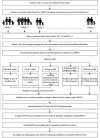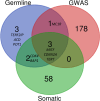Variant ranking pipeline for complex familial disorders
- PMID: 38866901
- PMCID: PMC11169219
- DOI: 10.1038/s41598-024-64169-3
Variant ranking pipeline for complex familial disorders
Abstract
Identifying genetic susceptibility factors for complex disorders remains a challenging task. To analyze collections of small and large pedigrees where genetic heterogeneity is likely, but biological commonalities are plausible, we have developed a weights-based pipeline to prioritize variants and genes. The Weights-based vAriant Ranking in Pedigrees (WARP) pipeline prioritizes variants using 5 weights: disease incidence rate, number of cases in a family, genome fraction shared amongst cases in a family, allele frequency and variant deleteriousness. Weights, except for the population allele frequency weight, are normalized between 0 and 1. Weights are combined multiplicatively to produce family-specific-variant weights that are then averaged across all families in which the variant is observed to generate a multifamily weight. Sorting multifamily weights in descending order creates a ranked list of variants and genes for further investigation. WARP was validated using familial melanoma sequence data from the European Genome-phenome Archive. The pipeline identified variation in known germline melanoma genes POT1, MITF and BAP1 in 4 out of 13 families (31%). Analysis of the other 9 families identified several interesting genes, some of which might have a role in melanoma. WARP provides an approach to identify disease predisposing genes in studies with small and large pedigrees.
© 2024. The Author(s).
Conflict of interest statement
The authors declare no competing interests.
Figures



Similar articles
-
A novel recurrent mutation in MITF predisposes to familial and sporadic melanoma.Nature. 2011 Nov 13;480(7375):99-103. doi: 10.1038/nature10630. Nature. 2011. PMID: 22080950 Free PMC article.
-
Multigene panel sequencing of established and candidate melanoma susceptibility genes in a large cohort of Dutch non-CDKN2A/CDK4 melanoma families.Int J Cancer. 2019 May 15;144(10):2453-2464. doi: 10.1002/ijc.31984. Epub 2019 Jan 21. Int J Cancer. 2019. PMID: 30414346 Free PMC article.
-
Genetic susceptibility to cutaneous melanoma in southern Switzerland: role of CDKN2A, MC1R and MITF.Br J Dermatol. 2016 Nov;175(5):1030-1037. doi: 10.1111/bjd.14897. Epub 2016 Aug 31. Br J Dermatol. 2016. PMID: 27473757
-
A germline oncogenic MITF mutation and tumor susceptibility.Eur J Cell Biol. 2014 Jan-Feb;93(1-2):71-5. doi: 10.1016/j.ejcb.2013.10.002. Epub 2013 Oct 26. Eur J Cell Biol. 2014. PMID: 24290354 Review.
-
Cancer risks associated with the germline MITF(E318K) variant.Sci Rep. 2020 Oct 13;10(1):17051. doi: 10.1038/s41598-020-74237-z. Sci Rep. 2020. PMID: 33051548 Free PMC article.
References
MeSH terms
Substances
Grants and funding
LinkOut - more resources
Full Text Sources

